2 西安交通大学全球环境变化研究院, 陕西 西安 710049)
中国东部地处东亚季风区,降水变率大,易发生干旱灾害。尤其是在当前全球变暖的大背景下,由于变暖导致的水循环加快与大范围的环流调整,中国干旱发生频次明显增加,强度增强;而且持续性干旱事件也在明显增多、增强[1]。严重的干旱灾害特别是持续多年的干旱灾害对国民经济、生命财产以及生态系统会造成巨大损害[2]。如观测数据显示在1950~2006年间中国共发生了5次最为突出的持续性干旱事件,分别发生在1962~1964年、1964~1970年、1974~1979年、1997~2003年和2004~2006年[3],其中最为严重的1997~2003年华北地区的持续性干旱迫使政府不得不从黄河引水济京津,以解缺水之急[4],1964~1970年中国东部的持续性干旱则造成大量人员的死亡[5]。因此,对于中国东部极端降水变化,特别是持续多年的严重旱涝事件的研究越来越受人们的关注。认识现代持续性旱涝事件的成因机制是非常重要的,因为在未来有可能会发生类似的持续性旱涝事件。然而现代持续性旱涝事件的成因机制研究面临的一个挑战则是如何区分自然因素和人类活动的相对贡献。古气候研究无疑是解决该问题的主要途径之一,为分辨人类活动影响提供了自然背景的理解。因此,认识现代持续性旱涝事件的成因与机制,需要放在历史气候演变的背景之下[6]。
利用历史文献记录、树轮、石笋、高分辨率湖泊沉积物等重要记录,科学家们重建了中国古气候变化序列,获得了大量的历史数据[6~15]。重建资料揭示过去千年严重的持续性干旱事件多有发生,其中许多事件的严重程度甚至超过现代的记录[6, 12]。如1637~1643年的干旱事件(通常又称崇祯大旱),其持续时间之长、受旱范围之大为近百年所未见[6]。前人对干旱事件的发生与发展过程、严重程度、伴生灾害、社会影响及与温度的联系也已做了大量的研究[16~20],并依据太阳活动、火山活动、海温状况等与干旱事件的对应关系推断了某些旱涝事件发生的可能原因[5, 20]。如Shen等[5]指出过去500年发生的3次超级干旱事件(1586~1589年、1638~1641年和1965~1966年)均发生在大火山活动和厄尔尼诺事件时期,可能受两者共同影响。然而由于重建资料数据点稀少及其空间分布的不均匀性,使得重建资料受地域性限制,难免存在代表性方面的问题,加之不同的代用指标对气候变化敏感性的差异,导致对过去千年中国东部持续性旱涝事件的认识存在不确定性。此外,对干旱事件的机制虽有简单对比分析,但由于缺乏大气环流场的相关资料而无法采用动力学方法对过去千年持续性干旱事件进行成因机理分析和探讨。数值模拟方法可以弥补重建资料不足,是研究气候变化非常重要的工具。中国区域古气候演变的模拟研究,近年来进展很快,并取得了丰硕的成果[21~39]。在过去千年中国东部持续性旱涝事件的模拟研究上,我们[25, 30]曾利用CCSM2.0.1(公共气候系统模式)模式模拟资料,评估了该模式模拟过去千年中国东部持续性旱涝事件的能力,并对成因机制做了初步探讨。结果发现CCSM2.0.1模式可以再现重建资料所揭示的10次持续性干旱事件中的6次事件,它们分别发生在1129~1144年、1186~1214年、1354~1365年、1435~1448年、1466~1491年和1631~1648年。由于1129~1144年、1354~1365年、1466~1491年和1631~1648年干旱事件均发生在太阳活动极小期,且仅考虑太阳辐射强迫的模拟试验也可以模拟到这4次干旱事件,据此推断太阳活动可能是引起这4次干旱事件的主要因素,但未能排除干旱事件受气候系统内部变率影响的可能性。我们对参与CMIP5/PMIP3(耦合模式比较计划第五阶段/古气候模式比较计划第三阶段)计划的5个模式模拟过去千年中国东部持续性干旱事件的能力也进行了初步分析,结果显示所有模式都无法完全正确地模拟过去千年中国东部的持续性干旱事件[25]。
由此可见,尽管气候系统模式已经成为过去千年气候演变及归因研究的重要工具,但是利用气候系统模式进行过去千年发生的持续性干旱事件的研究尚处于起步阶段。对过去千年中国东部持续性干旱事件的研究,需要减少模式的不确定性,从而提高模式模拟中国东部持续性干旱事件的能力,提升其对机理分析的可靠性。特别是模式模拟存在复杂的自然内部变率,使得利用单个强迫模拟试验无法完全正确的再现真实的气候变化,这或许也正是上述已有模拟研究工作所突显的模式不能完全正确模拟中国东部持续性干旱事件且无法区分外强迫和气候系统内部变率对形成持续性干旱事件各自贡献的主要原因之一。解决该问题的途径之一是利用控制试验不同时期状态作为初始条件驱动气候系统模式对过去千年气候变化进行集合模拟试验,集合平均用来与重建资料进行比较和进行成因机制解释。由于集合成员提供了独立的内部变率样本,集合平均可以过滤掉内部变率噪音[40],仅保留气候系统对强迫的响应。显然,对于成因机理分析,这种方法较混合了强迫响应和内部变率噪音的单个模拟试验分析结果有很显著的优势[41]。如利用CESM1.1模式过去千年集合模拟试验,Otto-Bliesner等[42]评估了模式模拟全球和区域平均温度、海冰、降水以及ENSO(厄尔尼诺-南方涛动)、AMO(北大西洋年代际震荡)等指数的能力并进行了归因检测,发现集合平均模拟结果与重建数据的一致性相较于单个过去千年气候变化模拟试验有很大的提高。然而,现有的过去千年气候变化集合平均模拟研究大都集中在千年来全球、半球和各区域大范围温度变化上,对分析千年来中国东部降水的变化鲜有涉及。本文将利用CESM1.1模式过去千年集合模拟试验结合重建资料对模拟的过去千年中国东部持续性严重干旱事件的成因机制进行初步探讨和分析。
1 资料来源重建资料采用Zheng等[12]利用历史记录重建的过去1500年10年精度的中国东部(25°~40° N,105°~122° E)旱涝指数(Dryness-Wetness Index,简称DWI)资料。该套资料是集成了根据中国古代文献、明清地方志、清代洪涝档案及民国档案等多种不同来源记载评定的旱涝等级记录,通过比值法定义区域干湿指数,采用多项式拟合记载数量变化趋势,剔除其对定量重建干湿序列均一性的影响来重建的[43]。另一采用的中国东部(约105° E以东,25°~41° N)旱涝等级资料源自《中国近五百年旱涝分布图集》[7],它是由中国气象学家根据2100多种地方志(通志、府志、县志等)、史记、近代的实测降水资料以及其它历史文献(如《古今图书集成》等)中关于旱涝记载作为原始材料,整编出来全国120个站点的逐年旱涝等级序列;其中,1级——涝,2级——偏涝,3级——正常,4级——偏旱,5级——旱;1、2、3、4和5个旱涝等级出现比例大致为10 %、25 %、30 %、25 %和10 %。这两套资料均可用来反映中国东部雨季降水(5~9月)变化情况[44~45]。
模拟资料来自于CESM1.1模式过去千年集合模拟试验结果(CESM-LME)[42]。CESM1.1模式是由美国NCAR(美国国家大气研究中心)于2010年7月推出的新一代地球系统模式,是一个完全耦合的气候模式。该模式由大气、海洋、陆地陆面、陆冰和海冰5个主要模块组成,利用耦合器实现5个模块之间的数据交换,其中大气模块和陆地陆面模块分辨率为2.0°×2.0°,海洋模块和海冰模块分辨率为1.0°×1.0°。本文采用CESM1.1模式过去千年集合模拟试验中的13次全强迫集合试验[42]进行过去千年中国东部持续性严重干旱事件的分析。其中每一次全强迫试验结果即称为全强迫集合试验中的一个集合成员。为了对干旱事件的发生成因机制进行分析,另外也采用了4次太阳活动单因子集合试验和5次火山活动单因子集合试验[42]结果进行分析。同样,每次单强迫试验结果即称为该单强迫集合试验中的一个集合成员。过去千年集合试验均以850年控制试验的第200年为其提供初始场,并对初始的大气温度场进行小的随机舍入差调整从而进行集合模拟,在强迫因子的驱动下,模式从850年积分至1850年。驱动模式的强迫因子中太阳总辐照度(TSI)的变化采用Vieira等[46]的重建数据,火山强迫采用的是Gao等[47]用冰芯推算的气溶胶随纬度、高度和月份变化而变化的数据,温室气体(CO2、CH4和N2O)是取自南极冰芯记录[48],土地利用强迫融合了Pongratz等[49]和Hurrt等[50]的重建数据,轨道参数则利用Berger[51]的方程计算,臭氧和气溶胶则维持为1850年值不变。
为了获得现代气候变化的模拟结果,对CESM-LME全强迫集合试验进行了扩展,积分至2005年,在现代气候集合模拟试验(1850~2005年)中除未考虑轨道参数变化及增加考虑了臭氧和气溶胶强迫之外,其它强迫则与过去千年全强迫集合模拟试验采用一致重建数据。本文选取850~1850年中国东部(25°~40° N,105°~122° E)雨季降水(5~9月)全强迫、太阳活动单因子强迫和火山活动单因子强迫模拟数据作为中国东部过去千年的降水模拟序列。所有模拟数据的距平都相对于850~1850年平均值计算得到。选取1850~2005年雨季降水(5~9月)全强迫模拟数据与观测资料进行比对,评估模式模拟中国东部现代降水的能力。
持续性严重干旱事件的定义方法有多种,其中Meehl和Hu[52]认为如果11年滑动平均后的区域平均降水距平序列中出现持续10年或以上为负值且其中至少有连续5年的负值超过阈值即一个标准差则为一次持续性严重干旱事件。该定义方法适用于具有10年分辨率重建序列及与其相比较的模拟序列的。本文采用类似的定义方法,只是将其中的阈值通过将全强迫集合模拟试验的降水序列按照升序排列后取样本的第90个百分位值(- 1.31δ)来定义。我们曾经利用Zheng等[12]重建的过去千年中国东部旱涝指数序列,并采用该定义方法,揭示出过去千年中国东部发生了10次持续性干旱事件[25]。ENSO指数采用Niño-3指数[53],即为Niño3区(150°~90°W,5°S~5°N)区域平均海表面温度距平序列。同样,ENSO序列也进行了11年滑动平均。
2 模式模拟能力评估为了验证CESM1.1集合试验模拟中国东部降水的可靠性和准确性,将13次1850~2005年全强迫试验进行集合平均,与美国气候预测中心的降水再分析资料[54](CMAP)以及第二版全球降水气候项目的降水资料[55](GPCP)进行了对比。图 1即为全强迫集合平均以及CMAP、GPCP观测资料所反映的1979~2000年中国东部(25°~40°N,105°~122°E)年平均降水气候平均态分布对比图,其中观测资料的降水数据均通过线性插值法从原来的2.5°×2.5°分辨率插值为与模式相同的分辨率2.0°×2.0°。
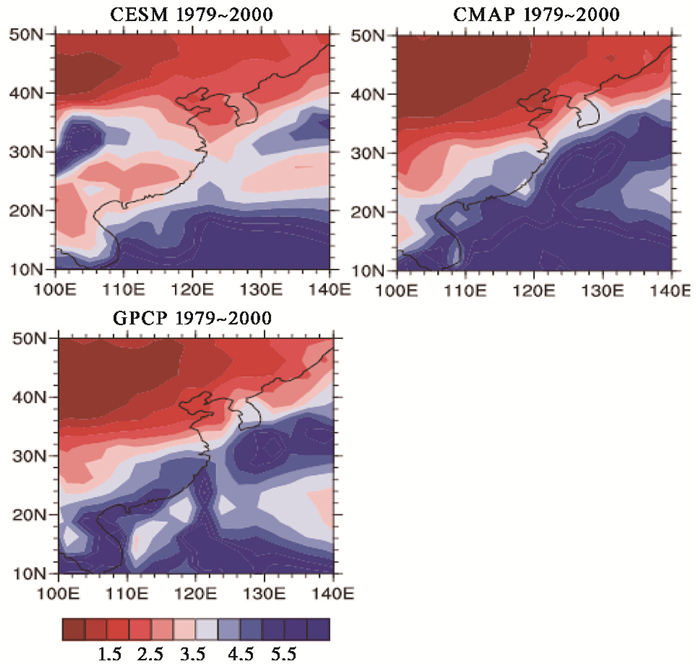
|
图 1 CESM-LME及观测资料CMAP和GPCP所反映的1979~2000年中国东部降水率的气候22年平均态(mm/天) Fig. 1 Spatial patterns of rainy season precipitation(mm/day) over Eastern China in modeled data of CESM-LME and observed data. All data are 22-a averages of 1979~2000 |
由图 1可知,模式能够模拟出观测资料所反映的中国东部降水空间分布特征,即降水呈带状分布,沿西南-东北方向,随纬度增加降水减少。但模式模拟的年平均降水率在青藏高原地区总体偏高,中国南部地区偏少,或许缘于CESM模式对于青藏高原大地形的影响刻画不足,这是目前耦合气候模式模拟中国降水时普遍面临的问题[56]。因此,CESM集合平均模拟的中国东部地区年降水的气候平均态较为真实,能够比较准确地反映出中国东部的降水空间分布特征。1979~2000年共22年平均的中国东部降水年变化(图 2)显示模拟数据和观测资料均表明降水在7月份达到最高值,在12月份达到最低值。且模拟数据3月和6月份降水与观测资料最为接近,其它时期偏高。比较结果表明,CESM集合平均模拟的降水季节变化在中国东部地区上的表现也是比较准确的,5~9月模拟的降水量与观测资料较为接近。
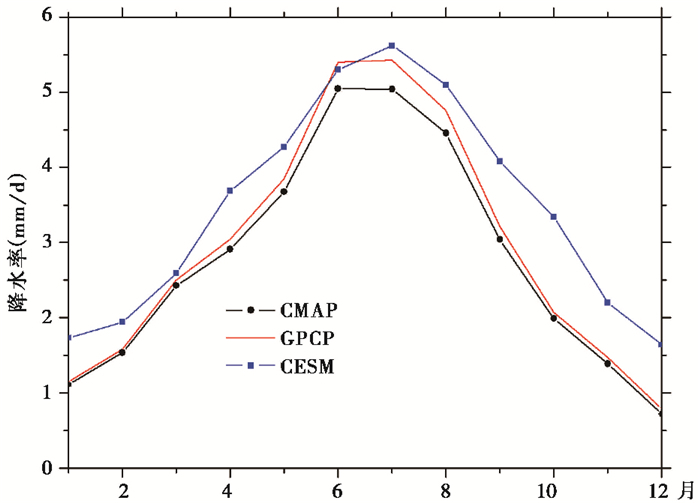
|
图 2 模拟和观测数据所反映的1979~2000年平均降水年变化 Fig. 2 Graphs of observed and modeled annual precipitation variations based on the monthly mean precipitation from 1979 to 2000 |
将CESM-LME13次全强迫集合试验得到的中国东部过去千年雨季降水序列进行集合平均,并对其进行11年滑动平均和标准化。结合持续性严重干旱事件的定义,结果发现CESM-LME全强迫集合平均模拟出过去千年中国东部发生了7次干旱事件,分别发生在883~910年、951~977年、1253~1305年、1327~1346年、1471~1488年、1587~1610年和1688~1699年(图 3)。对比旱涝指数序列,可以发现模拟的883~910年和1587~1610年这两次干旱事件与同时期DWI呈现相反的变化趋势,而951~977年、1327~1346年、1471~1488年和1688~1699年干旱事件与DWI呈现基本一致的变化趋势,1253~1305年干旱事件则前期与DWI一致呈现干旱趋势,但后期变化趋势两者相反。在相同的持续性严重干旱事件的定义下,只有模拟的1471~1488年的干旱事件与DWI所反映的1479~1495年干旱事件较为吻合(表 1),表明CESM-LME模拟过去千年持续性严重干旱事件的能力较低。
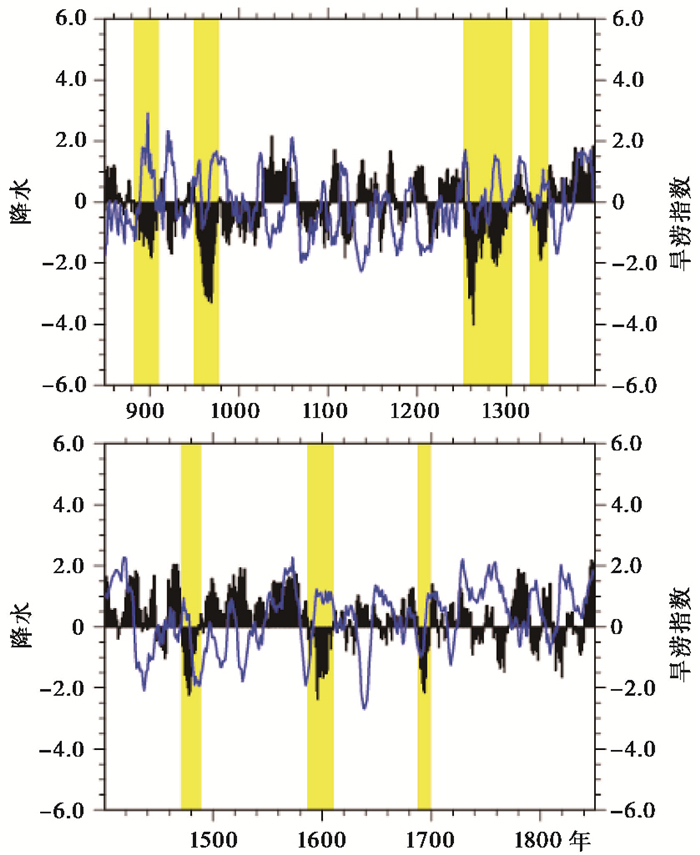
|
图 3
过去千年中国东部旱涝等级距平重建序列(蓝色实线)与全强迫集合平均模拟的雨季5~9月降水量距平标准化序列(柱状线)11年滑动平均曲线
黄色竖条为CESM-LME全强迫模拟试验集合 平均结果所反映的7次干旱事件 Fig. 3 11-year running mean curve of the standardized anomaly serial of simulated rainy season precipitation(May~September)(bars)and the serial of drought and flood index(solid line)over Eastern China. Seven droughts in CESM-LME full-forcing simulations are shown with yellow bars |
| 表 1 CESM-LME全强迫集合平均模拟资料和中国东部旱涝等级资料所反映的过去千年中国东部干旱事件* Table 1 Severe decadal droughts over Eastern China during the last millennium identified in proxy and simulated data |
可能的原因或许源自于重建资料和模拟数据的不确定性。其中重建资料的不确定性主要是因为受原始记载遗漏、失传与“记异不记常”、“厚今薄古”及地区间社会经济文化发展不平衡、战乱等多个因素影响,使得该DWI序列1470年之前的旱涝等级数据存在不同程度的缺值。当DWI数据点稀少及其空间分布不均匀时,或许会使得重建资料受地域性限制,使其存在代表性不足方面的问题。比如我们曾经将Zheng等[12]重建的旱涝指数序列与中国气象局重建的旱涝指数[7]进行了对比,发现数据点的多少对于判断中国东部旱涝状况的影响非常重要[25]。另外,由于DWI资料只能定性而不能定量的判断降水量的多少,DWI对过去千年中国东部持续性干旱事件的反映或许存在不确定性。因此,为了减少不确定性,未来需要进一步将模拟资料和DWI反映的持续性干旱事件与其他重建结果如石笋、树轮等结果进行比较。模拟数据的不确定性则来自于驱动模式的强迫因子及模式对强迫因子响应的不确定性和模式内部变率噪音的影响[25]。因此,有必要对模式模拟的中国东部干旱事件进行不确定性分析,从而有助于该模式模拟中国东部干旱事件能力的改进。另外,相较于集合模拟试验集合平均方法,古气候数据同化方法[57]是提升模式模拟能力更为有效的方法。在未来也需要采用将CESM模拟和DWI重建数据进行组合和优化的数据同化技术,即利用DWI重建数据来约束CESM模式的模拟使之与重建记录保持一致的方法来提升CESM模式模拟过去千年中国东部干旱事件的能力。
图 4为模拟的7次干旱事件时期降水距平的空间分布。如图 4所示,除1327~1346年主要为长江中下游干旱外,其他干旱事件均为南北同旱,但1587~1610年和1688~1699年干旱程度较之其他时期要弱。利用中国气象局根据历史文献资料重建的旱涝指数格点数据[7],对比了同时期旱涝指数空间分布特征。由于受该套数据时间长度限制,只能对比分析1471~1488年、1587~1610年和1688~1699年旱涝指数空间分布特征。结果显示,旱涝指数空间分布特征与模拟结果相类似,均显示为南北同旱的空间分布特征。其中1471~1488年持续性干旱事件干旱程度最强,并显示北方的干旱程度较南方更为严重,这与Zheng等[12]的DWI序列结果保持一致;1688~1699年干旱程度较弱,与DWI序列此时期较弱的干旱趋势相一致;1587~1610年偏干程度最弱,且呈现东部偏湿西部偏干的分布特征,与Zheng等[12]的DWI序列显示该时期中国东部较为湿润并不完全一致。
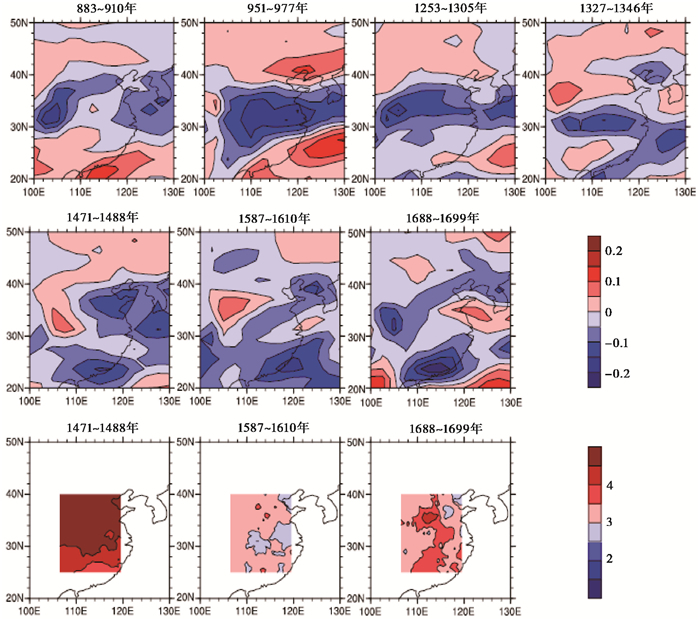
|
图 4 CESM-LME全强迫模拟试验集合平均所反映的7次和重建数据所反映的3次干旱事件降水(mm/天)空间分布 Fig. 4 Modeled precipitation anomalies(mm/day)of the seven droughts in CESM-LME full-forcing simulations and the last three regional droughts in historical records |
尽管与重建资料的对比结果表明模式反映过去千年中国东部持续性严重干旱事件的能力较低,但对模式所反映的过去千年中国东部持续性干旱事件的发生机制进行分析,不仅可以利用模拟结果探索中国东部干旱事件发生的可能因子及相应的动力学过程,也有助于分析模式模拟干旱事件时所具有的不确定性,从而有助于提升未来模式模拟中国东部干旱事件的能力。
为了初步分析干旱事件发生可能的影响因子,将全强迫模拟试验的集合平均降水结果与模拟的ENSO序列及重建的太阳活动和火山活动序列进行了简单的对比分析。图 5显示干旱事件与ENSO变化对应较为一致,所有的干旱事件发生时期ENSO均为负位相。并且我们注意到在其他ENSO为负位相时期,尽管中国东部未发生持续性严重干旱事件,但降水均呈现减少趋势,中国东部气候偏干,比如917~931年、984~1026年、1211~1224年、1448~1457年、1757~1770年和1811~1824年期间。由此可见,ENSO变化或许主导了CESM-LME中国东部干旱事件的发生。已有研究表明在年代际尺度上当ENSO处于负位相时,可以通过减弱沃克环流影响亚洲季风区的水汽输送,造成亚洲季风区降水出现年代际的减少[58~59]。干旱事件与太阳活动序列的对比结果表明干旱事件与太阳活动没有一致性,其中有5次持续性严重干旱事件发生在太阳活动极小期,它们分别为883~910年、1253~1305年、1327~1346年、1471~1488年和1688~1699年干旱事件,有两次干旱事件发生在太阳活动极大期或高值期,它们是951~977年和1587~1610年干旱事件。对比火山活动,则发现1253~1305年干旱事件发生在过去千年最强火山活动时期,1587~1610年干旱事件时期也有大火山活动发生。在另外两个火山活动活跃期即1450s和1810s,中国东部尽管未发生持续性严重干旱事件,但此时期模拟降水偏少,气候偏干。因此,火山活动或许也影响了模拟的中国东部干旱事件的发生。另外,我们观察到火山活动活跃期均对应着ENSO负位相。已有研究利用CMIP5/PMIP3多模式模拟结果指出太阳活动和火山活动会影响赤道太平洋地区海温分布[61~62]。因此,发生于太阳活动极小期和火山活动活跃期的干旱事件可能既受外强迫因子的影响,也受外强迫因子驱动下气候系统内部变率ENSO负位相状态的影响,如883~910年、1253~1305年、1327~1346年、1471~1488年、1587~1610年和1688~1699年干旱事件。
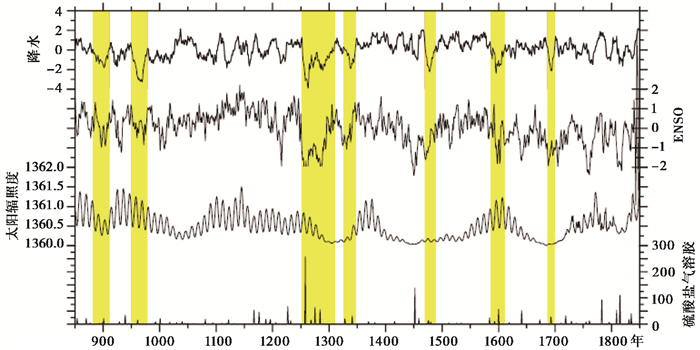
|
图 5 CESM-LME全强迫模拟试验集合平均降水、ENSO模拟结果及太阳活动(W/m2)、火山活动(Tg)强迫因子的比对 模拟曲线均进行了11年滑动平均,黄色竖条为CESM-LME全强迫模拟试验集合平均结果所反映的7次干旱事件 Fig. 5 Simulated rainy season precipitation and ENSO in full-forcing simulations, and climate records for solar(W/m2)and volcanic(Tg)forcing. Simulated data are 11-year running averages and standardized after smoothing. Seven droughts in CESM-LME full-forcing simulations are shown with yellow bars |
集合平均模拟虽然可以降低内部变率噪音的影响,但并不一定能完全过滤掉内部变率噪音的影响,为了评估模拟的7次干旱事件是否受到模拟内部变率噪音的影响,我们将集合平均结果与CESM-LME的13次全强迫试验结果进行了比较。图 6显示1327~1346年、1471~1488年和1688~1699年这3次干旱事件在各集合成员试验中表现出一致的干旱趋势,表明这几次干旱事件可能是对强迫的响应所致。1253~1305年干旱事件发生前期(1253~1270年)在各集合成员试验中表现出一致的干旱趋势,而在干旱事件后期(1271~1305年)各集合成员并没有表现出一致的干旱趋势,说明干旱事件前期可能是对强迫的响应所致,后期则可能受到模式内部变率噪音的影响。而在883~910年、951~977年和1587~1610年干旱事件时期各集合成员并没有表现出一致的干旱趋势,说明集合平均所反映的这3次干旱事件可能是由某些集合成员主导,它们可能受到模式内部变率噪音的影响。其中951~977年和1587~1610年干旱事件发生于太阳活动极大期或高值期,而883~910年和1587~1610年两次干旱事件也正好与DWI演变趋势相反,这说明模式内部变率噪音或许是导致CESM-LME模拟过去千年中国东部干旱事件具有不确定性的主要原因之一。
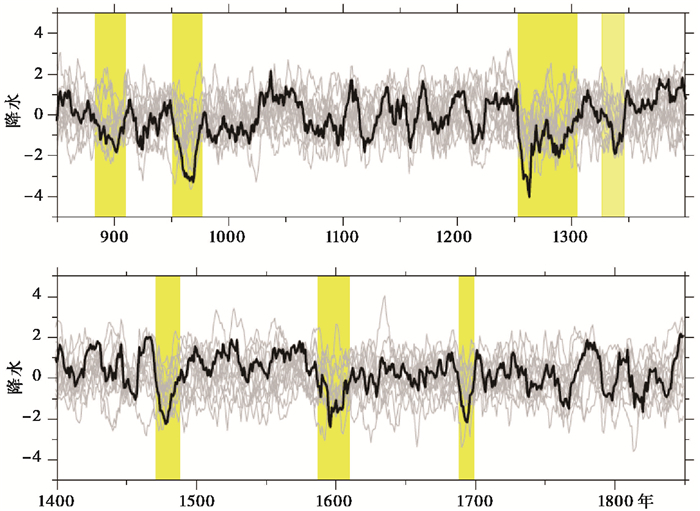
|
图 6 CESM-LME全强迫模拟试验集合平均结果(黑色实线)与13次全强迫模拟试验结果(灰色实线)间的比较 所有曲线均进行了11年滑动平均,黄色竖条为CESM-LME全强迫模拟试验集合平均结果所反映的7次干旱事件 Fig. 6 Comparisons of rainy season precipitation anomaly over Eastern China during the last millennium between ensemble mean(black solid line)and 13 ensemble members(gray solid line)in full-forcing simulations. All data are 11-year running averages and standardized after smoothing. Seven droughts in CESM-LME full-forcing simulations are shown with yellow bars |
综上所述,883~910年、951~977年、1587~1610年干旱事件以及1253~1305年干旱事件后期即1271~1305年由于受到模式内部变率噪音影响,因此,这4个时期对应的ENSO负位相无法确定是模式内部变率随机性所致,还是受到外强迫的驱动所致,需要进一步通过比较太阳活动和火山活动单因子强迫试验结果来分析。1253~1305年干旱事件前期即1253~1270年、1327~1346年、1471~1488年和1688~1699年这4次干旱事件可能是对外强迫的响应所致,其中1327~1346年、1471~1488年和1688~1699年干旱事件可能受太阳活动驱动,且太阳活动极小期还可能导致ENSO出现负位相,并进一步影响了中国东部干旱事件的发生。1253~1305年干旱事件前期即1253~1270年则可能即受太阳活动影响,也受火山活动影响。该事件前期在各集合成员试验中表现出一致的干旱趋势或许表明发生于1258年的过去千年最强火山活动及其驱动的ENSO负位相状态主导了该时期中国东部降水的变化。模式对该次干旱事件的高估,或许正是源于火山活动重建序列对该时期火山活动强度的高估[63],因此驱动模式模拟的强迫因子重建序列的不确定性或许是导致CESM-LME模拟过去千年中国东部干旱事件具有不确定性的另一个主要原因。
为了厘清外强迫和内部变率在模拟的7次持续性干旱事件中的影响,进一步对太阳活动和火山活动单因子强迫试验结果进行了分析。如图 7和8所示,全强迫集合试验所反映的883~910年、951~977年干旱事件在太阳活动和火山活动单因子强迫试验集合平均结果中都未有发生,且这两次干旱事件时期两个单因子强迫集合试验的各集合成员并没有表现出一致的变化趋势,再次证明它们在全强迫试验中或许是模式内部变率随机性所致。而1253~1305年干旱事件后期以及1587~1610年干旱事件后期则分别在太阳活动和火山活动单因子强迫集合试验中可以观察到一致的干旱趋势,因此可以推测太阳活动和火山活动分别在这两次干旱事件的后期扮演了一定的角色。对于之前推测可能受外强迫影响的几次干旱事件,图 8显示1253~1305年干旱事件前期确实受火山活动影响,在火山活动单因子强迫试验中各集合成员在该时期出现了一致的干旱趋势。因此,1253~1305年干旱事件可能受火山活动和太阳活动的共同影响,
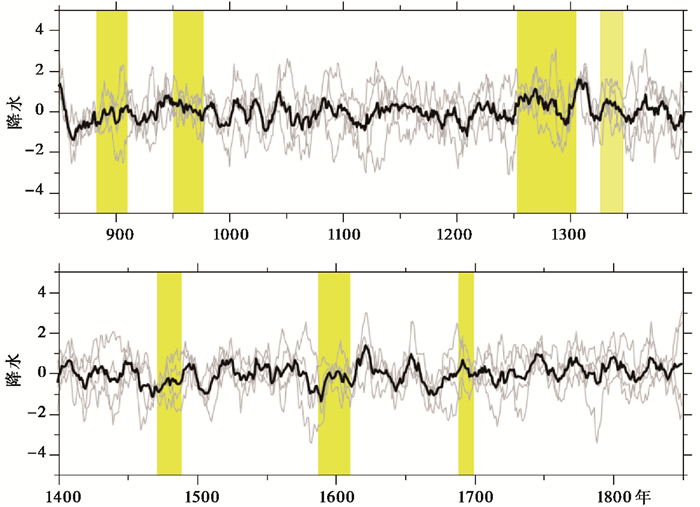
|
图 7 CESM-LME太阳活动强迫模拟试验集合平均结果(黑色实线)与4次太阳活动强迫模拟试验结果(灰色实线)的比较 所有曲线均进行了11年滑动平均;黄色竖条为CESM-LME全强迫模拟试验集合平均结果所反映的7次干旱事件 Fig. 7 Comparisons of rainy season precipitation anomaly over Eastern China during the last millennium between ensemble mean(black solid line)and 4 ensemble members(gray solid line)in solar forcing simulations. All data are 11-year running averages and standardized after smoothing. Seven droughts in CESM-LME full-forcing simulations are shown with yellow bars |

|
图 8 CESM-LME火山活动强迫模拟试验集合平均结果(黑色实线)与5次火山活动强迫模拟试验结果(灰色实线)的比较 所有曲线均进行了11年滑动平均;黄色竖条为CESM-LME全强迫模拟试验集合平均结果所反映的7次干旱事件 Fig. 8 Comparisons of rainy season precipitation anomaly over Eastern China during the last millennium between ensemble mean(black solid line)and 5 ensemble members(gray solid line)in volcanic forcing simulations. All data are 11-year running averages and standardized after smoothing. Seven droughts in CESM-LME full-forcing simulations are shown with yellow bars |
前期受1258年强火山活动影响,而后期则可能与太阳活动处于极小期有关。然而1327~1346年、1471~1488年和1688~1699年干旱事件却在太阳活动单因子强迫试验中各集合成员没有出现一致的干旱趋势,仅有1471~1488年干旱事件可以在太阳活动单因子强迫试验集合平均结果中观测到,证明之前对这3次干旱事件可能受太阳活动影响的推测具有不确定性。由于两个试验的集合成员并不相同,所以很难厘清这3次干旱事件究竟是否受太阳活动驱动。
5 结论本文利用CESM-LME过去千年13次集合试验结果,对模式模拟的过去千年中国东部持续性严重干旱事件的时空特征及发生机制进行了初步分析,得到以下结论:
(1) CESM-LME全强迫集合平均结果显示模式模拟出过去千年中国东部发生了7次持续性严重干旱事件,分别发生在883~910年、951~977年、1253~1305年、1327~1346年、1471~1488年、1587~1610年和1688~1699年。其中仅1471~1488年干旱事件与Zheng等[12]重建的旱涝指数序列保持一致,951~977年、1253~1305年、1327~1346年和1688~1699年干旱程度则被高估,而883~910年和1587~1610年这两次干旱事件与重建的旱涝指数变化趋势相反。除1327~1346年主要为长江中下游干旱,1471~1488年、1587~1610年和1688~1699年干旱事件空间分布特征与中国气象局利用历史文献资料重建的旱涝指数[7]空间分布特征相似,均为南北同旱。
(2) 7次干旱事件均对应ENSO负位相状态,其中1253~1305年干旱事件前期可能主要受火山活动驱动,后期则可能受到太阳活动和内部变率噪音的影响。另外1587~1610年干旱事件后期可能也受到火山活动的影响,该事件发生前期则可能受内部变率的影响。883~910年、951~977年干旱事件则完全受内部变率的影响。对1327~1346年、1471~1488年和1688~1699年这3次干旱事件,无法分辨外强迫和内部变率ENSO的各自贡献。
需要指出的是我们的模拟分析结果只是通过简单比对进行了模拟的中国东部干旱事件可能影响因子的初步分析,模式中外强迫因子和ENSO影响中国东部降水的动力学过程以及外强迫因子影响ENSO的机制是未来值得进一步探讨的科学问题。
致谢: 真诚地感谢审稿专家提出的建设性意见,感谢编辑部老师细致的编辑和指导!
| [1] |
Zhai J Q, Su B D, Krysanova V, et al. Spatial variation and trends in PDSI and SPI indices and their relation to streamflow in 10 large regions of China[J]. Journal of Climate, 2010, 23(3): 649-663. DOI:10.1175/2009JCLI2968.1 |
| [2] |
IPCC. Managing the risks of extreme events and disasters to advance climate change adaptation[M]//A Special Report of Working Groups Ⅰ and Ⅱ of the Intergovernmental Panel on Climate Change. Cambridge: Cambridge University Press, 2012: 582.
|
| [3] |
Wang A, Lettenmaier D P, Sheffield J. Soil moisture drought in China, 1950-2006[J]. Journal of Climate, 2011, 24(13): 3257-3271. DOI:10.1175/2011JCLI3733.1 |
| [4] |
荣艳淑, 段丽瑶, 徐明. 1997-2002年华北持续性干旱气候诊断分析[J]. 干旱区研究, 2008, 25(6): 842-850. Rong Yanshu, Duan Liyao, Xu Ming. Analysis on climatic diagnosis of persistent drought in North China during the period from 1997 to 2002[J]. Arid Zone Research, 2008, 25(6): 842-850. |
| [5] |
Shen C M, Wang W C, Hao Z X, et al. Exceptional drought events over Eastern China during the last five centuries[J]. Climatic Change, 2007, 85(3-4): 453-471. DOI:10.1007/s10584-007-9283-y |
| [6] |
张德二. 中国历史气候记录揭示的千年干湿变化和重大干旱事件[J]. 科技导报, 2004(8): 47-49. Zhang De'er. Variations of dry-wet climate and severe drought events in the climate records of China over the past 1000 years[J]. Science & Technology Review, 2004(8): 47-49. DOI:10.3321/j.issn:1000-7857.2004.08.015 |
| [7] |
中央气象局气象科学研究院主编.中国近五百年旱涝分布图集[M].北京: 地图出版社, 1981: 10. Chinese Academy of Meteorological Sciences, CNMA(Chinese National Meteorological Administration). Yearly Charts of Dryness/Wetness in China for the Last 500-year Period[M]. Beijing: Chinese Cartographic Publishing House, 1981: 10. |
| [8] |
史锋, 杨保, 赵森, 等. 全球过去千年典型暖期温度空间格局重建[J]. 第四纪研究, 2014, 34(6): 1125-1135. Shi Feng, Yang Bao, Zhao Sen, et al. Spatial pattern reconstruction of typical centennial warm periods of global temperature over the past millennium[J]. Quaternary Sciences, 2014, 34(6): 1125-1135. |
| [9] |
史锋, 杨保, 冯娟, 等. 利用树轮资料集成重建的过去2000年北半球年平均温度变化[J]. 第四纪研究, 2015, 35(5): 1051-1063. Shi Feng, Yang Bao, Feng Juan, et al. Reconstruction of the Northern Hemisohere annual temperature change over the common era derived from tree rings[J]. Quaternary Sciences, 2015, 35(5): 1051-1063. |
| [10] |
杨保, 王鑫, 宋苗, 等. 过去2000年温度集成重建研究:进展与展望[J]. 第四纪研究, 2017, 37(5): 945-962. Yang Bao, Wang Xin, Song Miao, et al. Temperature reconstructions of last millennium and common era climate variations:Present status and future prospects[J]. Quaternary Sciences, 2017, 37(5): 945-962. |
| [11] |
Cook E R, Anchukaitis K J, Buckley B M, et al. Asian monsoon failure and megadrought during the last millennium[J]. Science, 2010, 328(5977): 486-489. DOI:10.1126/science.1185188 |
| [12] |
Zheng J Y, Wang W C, Ge Q S. Precipitation variability and extreme events in Eastern China during the past 1500 years[J]. Terrestrial Atmospheric and Ocean Sciences, 2006, 17(3): 579-592. DOI:10.3319/TAO.2006.17.3.579(A) |
| [13] |
张志平, 黄伟, 陈建徽, 等. 全新世东亚夏季风演化的多尺度周期变化及其可能机制探讨[J]. 第四纪研究, 2017, 37(3): 498-509. Zhang Zhiping, Huang Wei, Chen Jianhui, et al. Multi-time scale analysis of East Asian summer monsoon and its possible mechanism during Holocene[J]. Quaternary Sciences, 2017, 37(3): 498-509. |
| [14] |
方克艳, 周非飞, 董志鹏, 等. 器测和树轮资料对厄尔尼诺-南方涛动指数的响应特征[J]. 第四纪研究, 2017, 37(5): 1064-1076. Fang Keyan, Zhou Feifei, Dong Zhipeng, et al. Responses of instrumental and tree-ring data to different indices of the El Niño-Southern Oscillation(ENSO)[J]. Quaternary Sciences, 2017, 37(5): 1064-1076. |
| [15] |
史江峰, 史逝远, 马晓琦, 等. 我国东南和华北季风区树轮气候和环境变化研究进展[J]. 第四纪研究, 2018, 38(6): 1471-1486. Shi Jiangfeng, Shi Shiyuan, Ma Xiaoqi, et al. Progress of tree-ring studies in climate and environment in Southeast China and North China[J]. Quaternary Sciences, 2018, 38(6): 1471-1486. |
| [16] |
Qian W, Hu Q, Zhu Y, et al. Centennial-scale dry-wet variation in East Asia[J]. Climate Dynamics, 2003, 21(1): 77-89. DOI:10.1007/s00382-003-0319-3 |
| [17] |
Qian W, Shan X, Chen D, Zhu C, et al. Droughts near the northern fringe of the East Asian summer monsoon in China during 1470-2003[J]. Climatic Change, 2012, 110(1-2): 373-383. DOI:10.1007/s10584-011-0096-7 |
| [18] |
张德二, 陆龙骅. 历史极端雨涝事件研究——1823年我国东部大范围雨涝[J]. 第四纪研究, 2011, 31(1): 29-35. Zhang De'er, Lu Longhua. Study of the large extent floodin g over Eastern China in 1823-As one of the extreme climatic event in history[J]. Quaternary Sciences, 2011, 31(1): 29-35. DOI:10.3969/j.issn.1001-7410.2011.01.05 |
| [19] |
张德二. 1755年中国东部极端雨涝事件研究[J]. 气候变化研究进展, 2012, 8(1): 1-7. Zhang De'er. Study of the large scale flooding over Eastern China in 1755-An extreme climatic event in history[J]. Advances in Climate Change Research, 2012, 8(1): 1-7. DOI:10.3969/j.issn.1673-1719.2012.01.001 |
| [20] |
葛全胜, 刘路路, 郑景云, 等. 过去千年太阳活动异常期的中国东部旱涝格局[J]. 地理学报, 2016, 71(5): 707-717. Ge Quansheng, Liu Lulu, Zheng Jingyun. Spatial patterns of drought/flood over Eastern China in the periods of anomalous solar activity during the past millennium[J]. Acta Geographica Sinica, 2016, 71(5): 707-717. |
| [21] |
Liu J, Wang B, Wang H, et al. Forced response of the East Asian summer rainfall over the past millennium:Results from a coupled model simulation[J]. Climate Dynamics, 2011, 36(1- 2): 323-336. |
| [22] |
王志远, 刘健. 过去2000年全球典型暖期特征与机制的模拟研究[J]. 第四纪研究, 2014, 34(6): 1136-1145. Wang Zhiyuan, Liu Jian. Modeling study on the characteristics and mechanisms of global typical warm periods over the past 2000 years[J]. Quaternary Sciences, 2014, 34(6): 1136-1145. |
| [23] |
韩春凤, 刘健, 王志远. 过去2000年亚洲夏季风降水百年尺度变化及其区域差异的模拟分析[J]. 第四纪研究, 2016, 36(3): 732-746. Han Chunfeng, Liu Jian, Wang Zhiyuan. Simulated analysis of Asian summer monsoon precipitation on centennial time scale and its regional differences over the past 2000 years[J]. Quaternary Sciences, 2016, 36(3): 732-746. |
| [24] |
孙炜毅, 刘健, 王志远. 东亚冬季风百年尺度变化特征及成因的模拟研究[J]. 第四纪研究, 2016, 36(3): 722-731. Sun Weiyi, Liu Jian, Wang Zhiyuan. Modeling study on the characteristics and causes of East Asian winter monsoon on centennial time scale[J]. Quaternary Sciences, 2016, 36(3): 722-731. |
| [25] |
Peng Y B, Shen C M, Cheng H, et al. Modeling of severe persistent droughts over Eastern China during the last millennium[J]. Climate of the Past, 2014, 9(6): 6345-6373. |
| [26] |
Peng Y B, Shen C M, Cheng H, et al. Simulation of the interdecadal Pacific Oscillation and its impacts on the climate over Eastern China during the last millennium[J]. Journal of Geophysical Research, 2015, 120(15): 7573-7585. |
| [27] |
Peng Y B, Shen C M, Wang W C, et al. Response of rainy season precipitation over Eastern China to large volcanic eruptions[J]. Journal of Climate, 2010, 23(3): 818-824. DOI:10.1175/2009JCLI2950.1 |
| [28] |
陈超, 沈新勇, 徐影. 过去1000年不同强迫因子对中国东部5-9月降水及其环流场特征影响分析[J]. 第四纪研究, 2011, 31(5): 873-882. Chen Chao, Shen Xinyong, Xu Ying. An analysis of precipitation and atmospheric circulation characteristics over Eastern China in the past millennium under different dorcing factors[J]. Quaternary Sciences, 2011, 31(5): 873-882. DOI:10.3969/j.issn.1001-7410.2011.05.12 |
| [29] |
Man W, Zhou T, Johann H. Simulation of the East Asian summer monsoon during the last millennium with the MPI earth system model[J]. Journal of Climate, 2012, 25(22): 7852-7866. DOI:10.1175/JCLI-D-11-00462.1 |
| [30] |
彭友兵, 徐影. 过去530年中国东部旱涝事件模拟研究初探[J]. 第四纪研究, 2009, 29(6): 1095-1103. Peng Youbing, Xu Ying. A modeling study on droughts and flood events of the last 530 years in East China[J]. Quaternary Sciences, 2009, 29(6): 1095-1103. |
| [31] |
燕青, 张仲石, 张冉, 等. 过去千年北大西洋热带气旋生成潜势的模拟研究:基于PMIP3气候模式[J]. 第四纪研究, 2017, 37(5): 1141-1150. Yan Qing, Zhang Zhongshi, Zhang Ran, et al. Simulation of tropical cyclone genesis potential over the North Atlantic in the last millennium based on PMIP3 models[J]. Quaternary Sciences, 2017, 37(5): 1141-1150. |
| [32] |
Yan Q, Zhang Z, Wang H J, et al. Simulated warm periods of climate over China during the last two millennia:The Sui-Tang warm period versus the Song-Yuan warm period[J]. Journal of Geophysical Research, 2015, 120(6): 2229-2241. |
| [33] |
王志远, 刘健, 王晓青, 等. 地球系统模式CESM 1.0对太阳辐射和温室气体的敏感性差异研究[J]. 第四纪研究, 2016, 36(3): 758-767. Wang Zhiyuan, Liu Jian, Wang Xiaoqing, et al. Divergent sensitivity of Earth System Model CESM 1.0 to solar radiation versus greenhouse gases[J]. Quaternary Sciences, 2016, 36(3): 758-767. |
| [34] |
靳春寒, 刘健, 王志远. 中国中世纪暖期温度年代际变化特征及成因分析[J]. 第四纪研究, 2016, 36(4): 970-982. Jin Chunhan, Liu Jian, Wang Zhiyuan. Study on the characteristics and causes of interdecadal temperature changes in China during the MWP[J]. Quaternary Sciences, 2016, 36(4): 970-982. |
| [35] |
王志远, 王江林, 张诗茄, 等. 不同时间尺度影响下的北半球夏季风空间特征及其可能影响机制[J]. 第四纪研究, 2018, 38(6): 1494-1506. Wang Zhiyuan, Wang Jianglin, Zhang Shijia, et al. Impact of different timescales on the characteristics and mechanisms of the Northern Hemisphere Summer Monsoon:Based on the CESM results[J]. Quaternary Sciences, 2018, 38(6): 1494-1506. |
| [36] |
Jiang D B, Yu G, Chen X, et al. Paleoclimate modeling in China:A review[J]. Advances in Atmospheric Sciences, 2015, 32(2): 250-275. DOI:10.1007/s00376-014-0002-0 |
| [37] |
姜大膀, 田芝平. 末次冰盛期和全新世中期东亚地区水汽输送的模拟研究[J]. 第四纪研究, 2017, 37(5): 999-1008. Jiang Dabang, Tian Zhiping. Last Glacial Maximum and mid- Holocene water vapor transport over East Asia:A modeling study[J]. Quaternary Sciences, 2017, 37(5): 999-1008. |
| [38] |
焦腾腾, 李佳瑞, 陈婕, 等. 全新世北大西洋海面温度变化趋势:观测-模拟对比研究[J]. 第四纪研究, 2016, 36(3): 747-757. Jiao Tengteng, Li Jiarui, Chen Jie, et al. Changing trends of sea surface temperatures in the North Atlantic during the Holocene:A study of model-data comparison[J]. Quaternary Sciences, 2016, 36(3): 747-757. |
| [39] |
张肖剑, 靳立亚. 全新世南亚高压南北移动及其与亚洲夏季风降水的关系[J]. 第四纪研究, 2018, 38(5): 1244-1254. Zhang Xiaojian, Jin Liya. Meridional migration of the South Asian High and its association with Asian summer monsoon precipitation during the Holocene[J]. Quaternary Sciences, 2018, 38(5): 1244-1254. |
| [40] |
Goosse H, Renssen H, Timmermann A, et al. Internal and forced climate variability during the last millennium:A model-data comparison using ensemble simulations[J]. Quaternary Science Reviews, 2005, 24(12-13): 1345-1360. DOI:10.1016/j.quascirev.2004.12.009 |
| [41] |
Goosse H, Renssen H, Timmermann A, et al. Using paleoclimate proxy-data to select optimal realisations in an ensemble of simulations of the climate of the past millennium[J]. Climate Dynamics, 2006, 27(2-3): 165-184. DOI:10.1007/s00382-006-0128-6 |
| [42] |
Otto-Bliesner B L, Brady E C, Fasullo J, et al. Climate variability and change since 850 CE:An ensemble approach with the Community Earth System Model[J]. Bulletin of the American Meteorological Society, 2016, 97(5): 735-754. DOI:10.1175/BAMS-D-14-00233.1 |
| [43] |
葛全胜, 郑景云, 郝志新, 等. 过去2000年中国气候变化研究的新进展[J]. 地理学报, 2014, 69(9): 1248-1258. Ge Quansheng, Zheng Jingyun, Hao Zhixin, et al. State-of-the- arts in the study of climate change over China for the past 2000 years[J]. Acta Geographica Sinica, 2014, 69(9): 1248-1258. |
| [44] |
Zheng J Y, Wu M W, Ge Q S, et al. Observed, reconstructed, and simulated decadal variability of summer precipitation over Eastern China[J]. Journal of Meteorological Research, 2017, 31(1): 49-60. DOI:10.1007/s13351-017-6115-5 |
| [45] |
Shen C M, Wang W C, Hao Z X, et al. Characteristics of anomalous precipitation events over Eastern China during the past five centuries[J]. Climate Dynamics, 2008, 31(4): 463-476. DOI:10.1007/s00382-007-0323-0 |
| [46] |
Vieira L E A, Solanki S K, Krivova N A, et al. Evolution of the solar irradiance during the Holocene[J]. Astronomy Astrophysics, 2011, 531(2): 576-587. |
| [47] |
Gao C C, Robock A, Ammann C. Volcanic forcing of climate over the past 1500 years:An improved ice core-based index for climate models[J]. Journal of Geophysical Research, 2008, 113(D23): 111. |
| [48] |
Schmidt G A, Jungclaus J H, Ammann C M, et al. Climate forcing reconstructions for use in PMIP simulations of the last millennium(v1.0)[J]. Geoscientific Model Development, 2011, 4(1): 33-45. DOI:10.5194/gmd-4-33-2011 |
| [49] |
Pongratz J, Reick C H, Raddatz T, et al. A reconstruction of global agricultural areas and land cover for the last millennium[J]. Global Biogeochem Cycles, 2008, 22(3): GB3018. |
| [50] |
Hurtt G C, Chini L P, Frolking S. Harmonization of land-use scenarios for the period 1500-2100:600 years of global gridded annual land-use transitions, wood harvest, and resulting secondary lands[J]. Climatic Change, 2011, 109(1): 117-161. |
| [51] |
Berger A L. Long-term variations of daily insolation and Quaternary climatic changes[J]. Journal of the Atmospheric Sciences, 1978, 35(12): 2362-2367. DOI:10.1175/1520-0469(1978)035<2362:LTVODI>2.0.CO;2 |
| [52] |
Meehl G, Hu A. Mechanisms of drought in present and future climate[C]//Program for the 33rd Annual Climate Diagnostics & Prediction Workshop/CLIVAR Drought Workshop. Lincoln, 2008: 3.
|
| [53] |
Wittenberg A T, Rosati A, Lau N C, et al. GFDL's CM2 Coupled Climate Models. Part.Ⅲ:Tropical Pacific climate and ENSO[J]. Journal of Climate, 2006, 19(5): 698-722. DOI:10.1175/JCLI3631.1 |
| [54] |
Xie P P, Arkin P A. An intercomparison of Gauge observations and satellite estimates of monthly precipitation[J]. Journal of Applied Meteorology, 1995, 34(5): 1143-1160. DOI:10.1175/1520-0450(1995)034<1143:AIOGOA>2.0.CO;2 |
| [55] |
Adler R F, Huffman G J, Chang A, et al. The version -2 global precipitation climatology project (GPCP) monthly precipitation analysis(1979-present)[J]. Journal of Hydrometeorology, 2003, 4(6): 1147-1167. DOI:10.1175/1525-7541(2003)004<1147:TVGPCP>2.0.CO;2 |
| [56] |
Jiang D B, Tian Z P, Lang X M. Reliability of climate models for China through the IPCC Third to Fifth Assessment Reports[J]. International Journal of Climatology, 2016, 36(3): 1114-1133. DOI:10.1002/joc.2016.36.issue-3 |
| [57] |
Goosse H, Renssen H, Timmermann A, et al. Using paleoclimate proxy-data to select optimal realisations in an ensemble of simulations of the climate of the past millennium[J]. Climate Dynamics, 2006, 27(2-3): 165-184. DOI:10.1007/s00382-006-0128-6 |
| [58] |
Ning L, Liu J, Sun W. Influences of volcanic eruptions on Asian summer monsoon over the last 110 years[J]. Scientific Reports, 2017, 7: 42626. DOI:10.1038/srep42626 |
| [59] |
Zhang X Z, Wu M W, Liu Yang, et al. The relationship between the East Asian summer monsoon and El Niño-Southern Oscillation revealed by reconstructions and a conctrol simulation for millennium[J]. Quaternary International, 2018, 493(10): 106-113. |
| [60] |
Xu T, Shi Z G, AN Z S. Responses of ENSO and NAO to the external radiative forcing during the last millennium:Results from CCSM 4 and MPI-ESM-P simulations[J]. Quaternary International, 2017, 487(10): 99-111. |
| [61] |
Le T. ENSO response to external forcing in CMIP 5 simulations of the last millennium[J]. Global and Planetary Change, 2017, 148: 105-112. DOI:10.1016/j.gloplacha.2016.12.002 |
| [62] |
Lewis S C, LeGrande A N. Stability of ENSO and its tropical Pacific teleconnections over the last millennium[J]. Climate of the Past, 2015, 11(10): 1347-1360. DOI:10.5194/cp-11-1347-2015 |
| [63] |
Sigl M, McConnell J R, Toohey M. Insights from Antarctica on volcanic forcing during the Common Era[J]. Nature Climate Change, 2014, 4: 693-697. DOI:10.1038/nclimate2293 |
2 Institute of Global Environmental Change, Xi'an Jiaotong University, Xi'an 710049, Shaanxi)
Abstract
We use modeled data from the Community Earth System Model Last Millennium Ensemble (CESM-LME)project and paleo-proxy records to examine the occurrence of severe event of persistent drought over Eastern China during the last millennium and diagnose the mechanisms. Modeled data are CESM 1.1 simulations for the CESM-LME project include an ensemble of 13 simulations with all forcings. To assess the influence of solar forcing and volcanic forcing, smaller ensembles with each forcing separately including an ensemble of 4 simulations with solar forcing and an ensemble of 5 simulations with volcanic forcing are also used. The paleo-proxy records include a data set of the dryness-wetness index (DWI)over Eastern China (25°~41°N, 105°~122°E, ) during the last 530 years which derived from Chinese historical documents and a data set of regional DWI over Eastern China (east of approximately 25°~40°N, 105°E)during the last 1500 years. Here, severe events of persistent drought in the model are defined as periods with a rainy season (May-September)precipitation anomaly of at least widespread (over Eastern China, 25°~40°N, 105°~122°E), persistent (less than zero for at least 10 consecutive years)and great precipitation anomaly (severe drought). To consider the intensity, we selected the periods of negative values of 10-year running mean of precipitation for Eastern China exceeding 1.31 times the standard deviation for at least 5 consecutive years. -1.31δ was used here as a threshold to classify the severity of severe drought, which corresponds closely to the drought classification scheme of 10% occurrence. The same approach is also applied to identify the severe decadal drought in the proxy data.In this drought classification, the model was simulated seven droughts over the study area during the last millennium such as those that occurred during the periods of 883~910, 951~977, 1253~1305, 1327~1346, 1471~1488, 1587~1610 and 1688~1699. To assess the possible linkage between the simulated severe decadal droughts and sea surface temperatures (SSTs)in the Pacific Ocean during the last millennium, we examine the simulated Niño3 index. It is calculated with SSTs in the box 150°~90°W, 5°S~5°N. The model results suggest the El Niño-Southern Oscillation (ENSO)plays an important role in precipitation variability, a temporally consistent relationship between the droughts and negative phases of ENSO could be found in the modeled data. The precipitation during the periods 1253~1305 exist coherent evolution among the individual all-forcing simulations is simulated leading to large fluctuations in the ensemble average. Similar to the results in all forcing simulations, the ensemble response in volcanic forcing simulations is outstandingly coherent during the early periods of the drought 1253~1305 and the latter periods of the drought 1587~1610. These analyses indicate that large volcanic eruptions may cause the droughts of 1253~1305 and play a important role in 1587~1610 events. Simulated precipitation evolves rather incoherently among the individual all-forcing simulations, solar forcing simulations and volcanic forcing simulations during the droughts occurred 883~910, 951~977. It indicated simulated precipitation during these periods describes an internal mode of climate variability which is rather resilient to external natural perturbations. Thus, 883~910, 951~977 drought events may be related to internal variability such as ENSO. However, it remains an open question whether the 1327~1346, 1471~1488 and 1632~1645 droughts, as identified by the model, can be or not be considered as driven by solar forcing. Droughts simulated in CESM disagree with the proxy record in East China except the drought occurred in 1471~1488, suggesting that model East Asian summer monsoon representation cannot be solely responsible. Possible explanations include issues with the uncertainties in the reconstructions, including forcing and precipitation and the models of chaotic components of internal variability. 2019, Vol.39
2019, Vol.39
